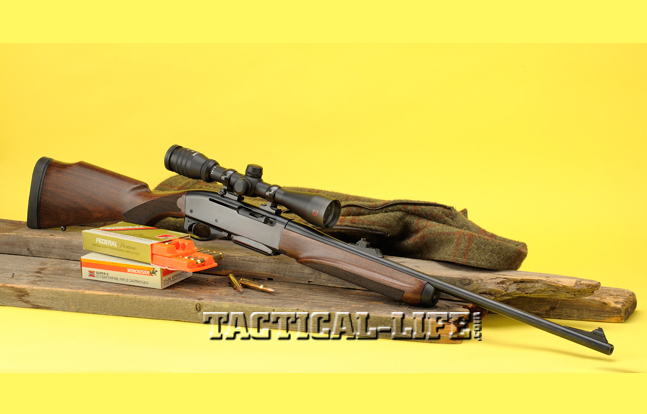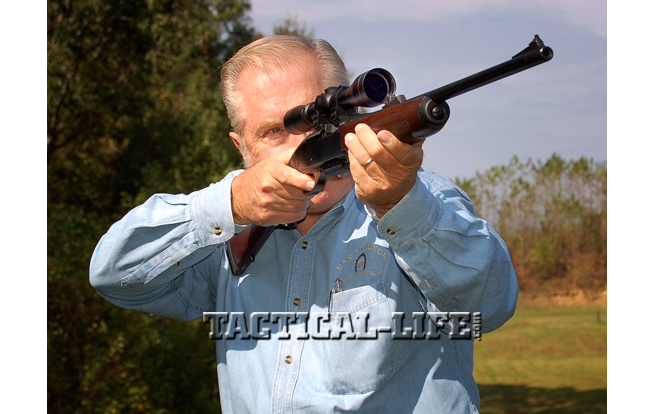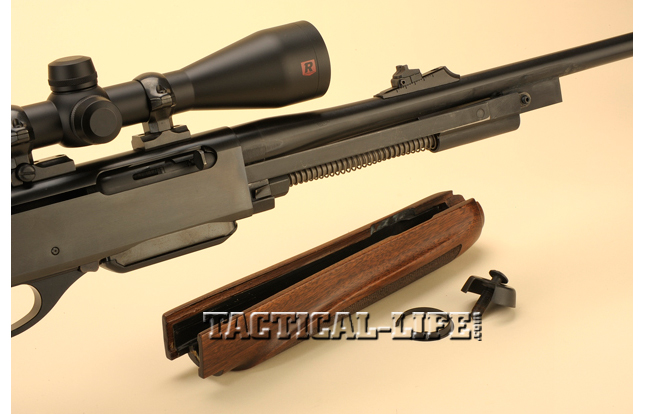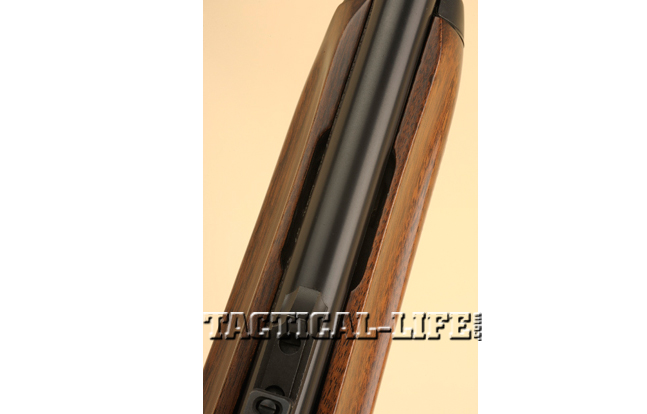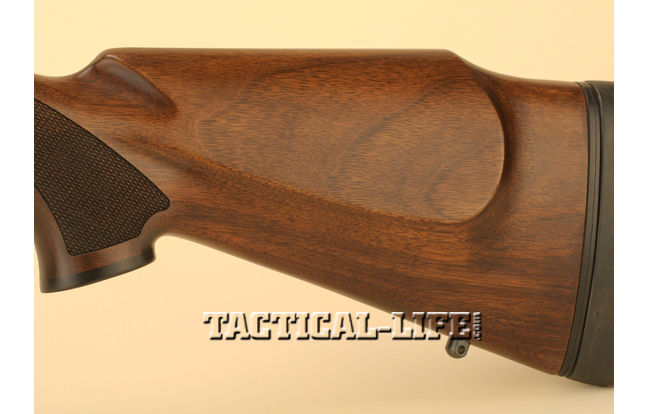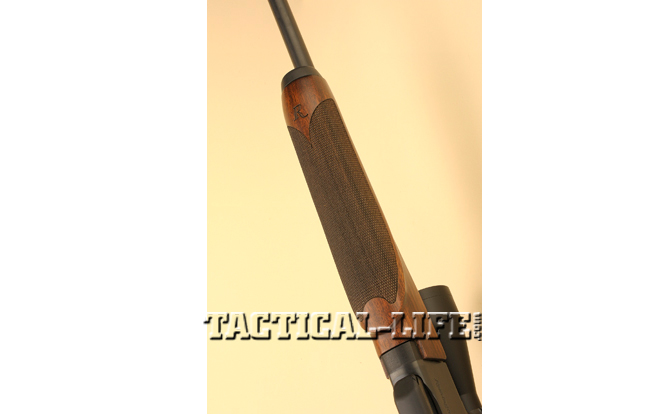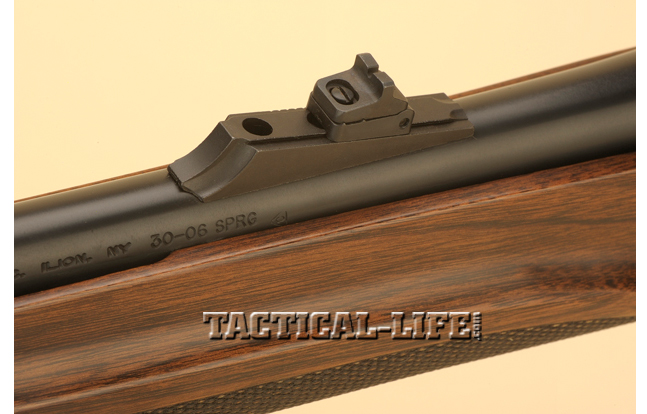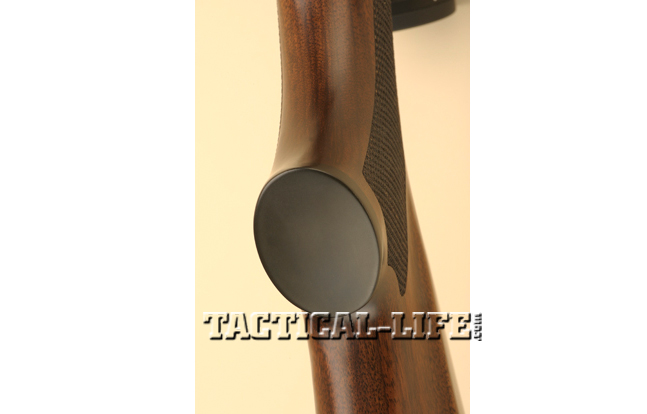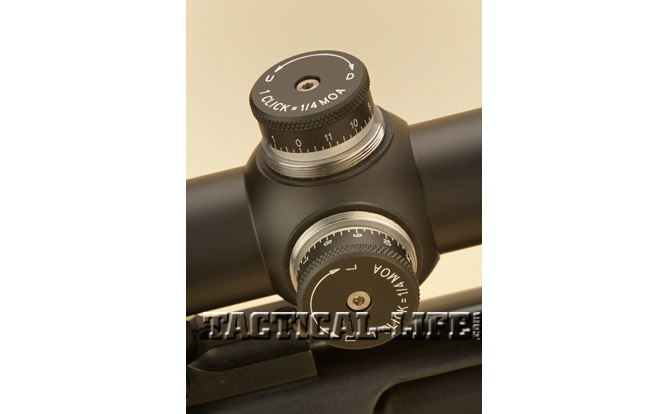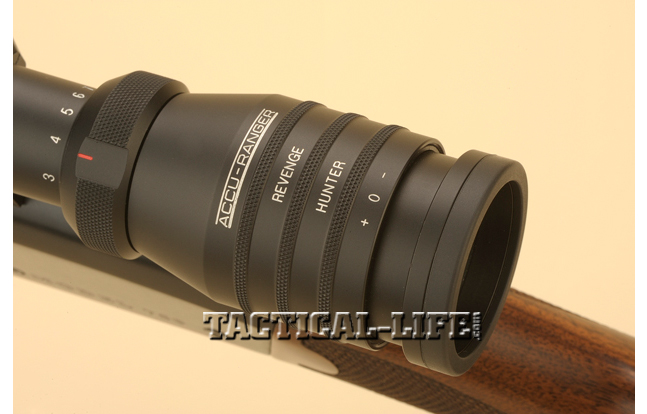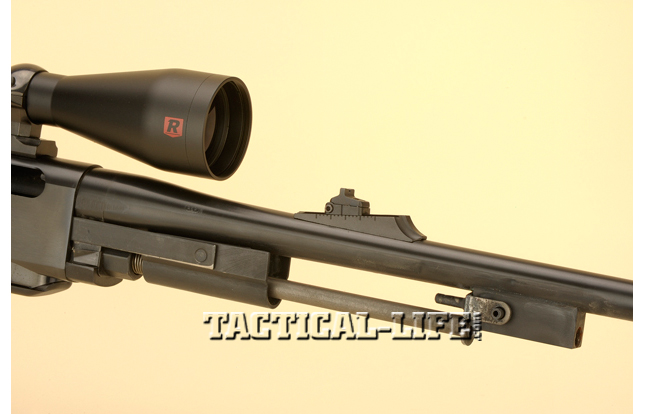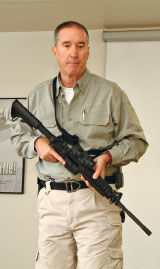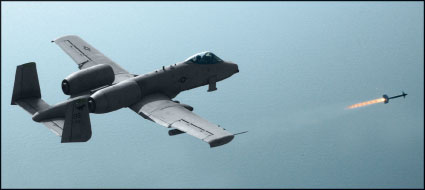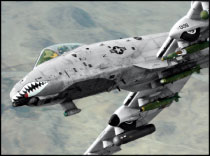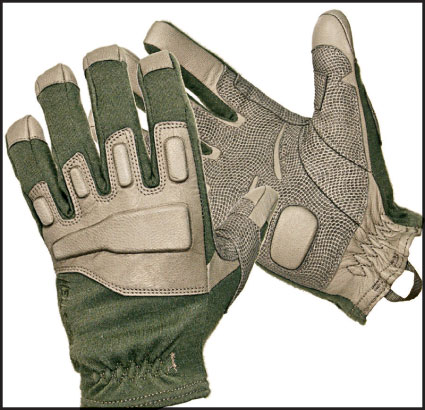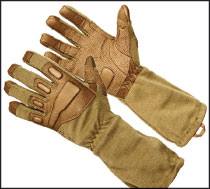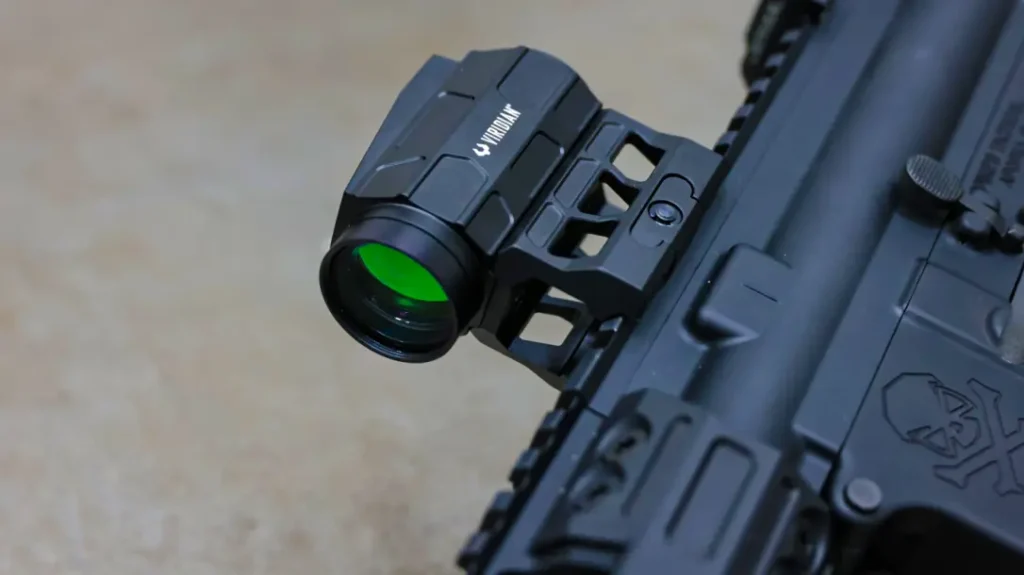Ever since the introduction of their first and highly successful Model 8 autoloading rifle, Remington Arms has kept a steady advance on that part of their product line. That was back in 1906, and through the last century Remington has placed more than their share of dependable semi-automatic rifles in the hands of American shooters with a wide variety of popular cartridge choices and stock design.
Rich History
Manufactured under a royalty-producing basis with John Browning, the Model 8 was designed as a hammerless, solid breech rifle that chambered the .25, .30, .32 and .35 Remington cartridges. It had a 22-inch barrel that recoiled within the confines of a rigid metal barrel jacket. Made with a straight grip—or English design—this new invention to the shooting world held five rounds within a box magazine which, at the shooter’s option, be loaded singly or with a full clip and sold for $30 retail.
Advertisement — Continue Reading Below
This particular gun was so successful that the counterpart and somewhat improved version was not brought on line until some 30 years later! Called the Model 81 Woodsmaster, it had a new, more traditional hunting styled stock and a semi-beavertail forend. Like the Model 8, it was produced in five ascending grades to satisfy even the most discriminating sportsman.
In 1955 the first fully gas-operated, non-recoiling barrel type of hunting rifle called the Model 740 Woodsmaster was introduced. With a newly designed rotating and multi-lug breech bolt that actually locked into the barrel, it was only chambered for the .30-06 Springfield and retailed for $124.95. Two years later, you could purchase this rifle for the .244 Remington and .308 Winchester; in 1958, the flat-shooting .280 Remington was added.
From here, it was uphill! In 1960 the Model 742 was introduced with improved handling and stock features that included a checkered stock and a grip cap. In 1961, the first short-barreled carbine version hit the market, and through 1964 additional cartridges were added to the line. Around 1966, the Model 742 BDL had stocks with a full cheekpiece that could be ordered for either right- or left-hand shooters.
Advertisement — Continue Reading Below
Some 15 years later, the Model 742 was dropped from the product line with the Model Four and 7400 taking its place. Out of the pair the Model Four was the deluxe version; the Model 7400 being touted as the “regular” version. In 1994, a SP or “Special Purpose” gun was brought on line and four years later, a synthetic edition was added. From here to the present, the Model 7400 was the only gun in the semi-automatic line but it was available in either a traditional rifle or carbine gun in .30-06 Springfield only.
While the Model 7400 is history, a newly upgraded gun called the Model 750 Woodsmaster joined the line of Remington semi-automatic rifles in 2006. This new model not only looks better in the appearance department, but with internal operating enhancements now allows the gun to be even more dependable than before. I’d like to mention here that through all my years of evaluating and shooting semi-automatic rifles the only problems I’ve ever had with a Remington automatic was due to my own handloads which in some cases failed to make the power threshold needed to function the gun properly. These tests included detailed handloads that were made up especially to see how low I could go to make a so-called “reduced loads” for younger hunters or for those recoil-sensitive shooters that flinch with even the soft recoil sensation of a gas-operated automatic weapon.
Model 750
Advertisement — Continue Reading Below
The current Model 750 is the best-looking Remington semi-automatic to date. The butt stock itself has been updated to modern standards and includes a lower monte-carlo comb for improved eye to scope contact when mounting the rifle. Presently, a substantial cheekpiece on the left side has been tastefully designed to handle the facial dimensions for those of us that always seem to be either above or below the physical dimensions of the “average” shooter. For a custom touch, there is a black pistol grip cap and to dampen the recoil effects even more, a full R3 soft recoil pad has been installed. The forearm is brand new and is semi-beavertail in design. Two finger grooves grace each side and the effect is quite pleasing as now the forward taper of this part of the stock sits naturally in the left hand as you ready the gun for shooting.
On this new model, there is more than an ample amount of checkering on both the forearm and pistol grip. Again, almost custom in appearance, this is a new pattern for Remington that combines the traditional point pattern with a modern accent in the form of curves, rather than points, around each corner. On the forearm, the checkering not only covers the bottom of this piece of wood, but also works its way up the sides for an improved purchase of the gun even with bulky winter gloves on. To add a touch of class, the flying “R” is laser-engraved near the upper quadrant of the checkering and both the buttstock and forearm are finished in an elegant walnut tone, and then sealed with a satin, urethane type of finish. Furthermore, a synthetic stocked version is available for hunters who desire a truly “all-weather” rifle.
Outside, the Model 750 retains much of the identical profile as its predecessors. The receiver shares the same look as the popular Model 1100 series of shotguns, giving the shooter an uninterrupted sighting plane if he chooses to use the supplied iron sights over optical goods. Both sides of the receiver are polished to a smooth luster and deeply blued. For engravers, the Model 750 offers plenty of open space totaling up to 15 square inches per side for those shooters willing to go the distance in decoration and gold trim.
Advertisement — Continue Reading Below
The Gun’s Guts
While cosmetics make a good-looking gun, it’s what’s inside that counts especially on an automatic weapon. With the Model 750, Remington improved, massaged and redesigned some of the internals to enhance both accuracy and performance. To start, they moved the gas orifice holes rearward about three-quarters of an inch to cut back on potential fouling and to increase feeding reliability and bolt velocity which in the overall picture seemed to benefit the shorter barreled carbine version the most. Additionally, Remington redesigned the barrel extension; again to improve and/or cancel out any feeding problems that might appear further down the line. In the final machining operation, they have improved the surface finish of the bolt itself by eliminating any burrs within the locking lug cuts.
Inside you’ll still find that reliable rotary-bolt design that, in concert with the gas operation, makes this gun truly dependable in the field. Trigger pull on any Model 750 / 7400 series gun is not one of its strongest points and even with a modest amount of slack still broke at a most unsatisfactory seven pounds. For safety, the traditional cross-button has been installed behind the trigger guard. Pushing it to the right locks the trigger, to the left unlocks the rifle to be fired. The Model 750 is equipped with a detachable magazine that holds four rounds of ammunition and is interchangeable with current Model 7400 series guns. The bolt release is located on the left hand side of the magazine and with a push forward drops the follower unlocking the bolt, striping a round from the magazine and sending it home. Operation of this release positions the hand and fingers away from the enthusiastic forward motion of the bolt as it gains momentum on its way to the breech, loading a round and finishing up with a solid lock up prior to firing. Spare magazines are inexpensive and fit both the Model 750 and 7400 guns, and with an extra tucked inside a preferred jacket, this is the perfect way to carry various bullet weights or different loads to your favorite hunting spot.
Advertisement — Continue Reading Below
Presently, the Model 750 is available in both the standard and a shorter, carbine-based rifle. With the former, barrel length is 22 inches and is chambered for the .243 Winchester, .308 Winchester, .270 Winchester, and .30-06 Springfield. The carbine variant has an 18.5-inch barrel and is only available in .308 Winchester and .30-06 Springfield. A few years back, the Model 750 was chambered for the .35 Whelen, but regrettably, that has been discontinued from the lineup. I used that cartridge in Canada with a prototype Remington Model 700 Classic many years back with great results on deer.
Redfield
I did mount a recently introduced Redfield Revenge 3-9x40mm scope with a set of spare Bushnell rings and two-piece bases I had in stock. For the record, if you have a base set labeled for the Remington Model 7400, it will fit perfectly. For close in or for hunting in thick underbrush, the Model 750 is also equipped with iron sights. On the rear of the barrel, the sight assembly moved back and forth, and side to side with a minor adjustment of a single setscrew. At the muzzle of the barrel, there is a fixed sight complete with a white bead, which fits perfectly into the notch on the rear sight. All sighted in, and chambered for the popular .30-06 Springfield, I was ready for formal testing at the range. Celebrating over a 100 years of service, it’s still hard to beat the popularity and versatility of this .30-caliber selection.
Advertisement — Continue Reading Below
Range Time
Rounding up a general selection of bullet weights, the first one up was Winchester’s 150-grain Power Point. At 100 yards, the gun placed groups which turned out to be the best of the day at 1.5 inches with average velocity readings around 2,832 fps. Following that, I averaged 2.5 inches with the Remington 165-grain Core-Lokt soft point, and finally with the Federal 180-grain Boat Tail Soft Point, my mean circled two inches. Within the confines of my morning of range testing, I had no trouble with any brand, regardless of bullet weight in feeding, extraction or ejection of any round placed into the magazine.
Now, if you are looking for a comparison concerning the apparent recoil sensation on your shoulder, here is my opinion. Out of the Browning BAR and the Benelli R1, I found the Model 750 to be about in the middle of the two with the BAR having the least and the Benelli just a bit more than the Model 750, but not by much. With regards to accuracy, today’s semi-automatic rifles will shoot minute or even sub-minute of angle groups with tailored handloads as will many other types of rifles. For medium to larger game, the Model 750 is more than enough gun to do the job with .30-caliber cartridges and heavier bullets to match—although I still think that Remington should keep the .35 Whelen in the lineup if only on special order perhaps once a year or possibly through the Custom Shop in an upgraded (production type) model. For smaller game and varmints with perhaps the .243 Winchester version, coyotes are fair game, but for smaller critters like woodchucks, and unless I could be completely sure with dedicated handloads, I would opt for a “varmint” rifle in a .22 centerfire caliber instead.
Advertisement — Continue Reading Below
Final Notes
I have spent a lot of time in the company of semi-autos and find them accurate and dependable. With the 750, Remington has done a good job in resurrecting the image of the 7400 series gun and has accomplished it in grand style. For more information, visit remington.com or call 800-243-9700.
